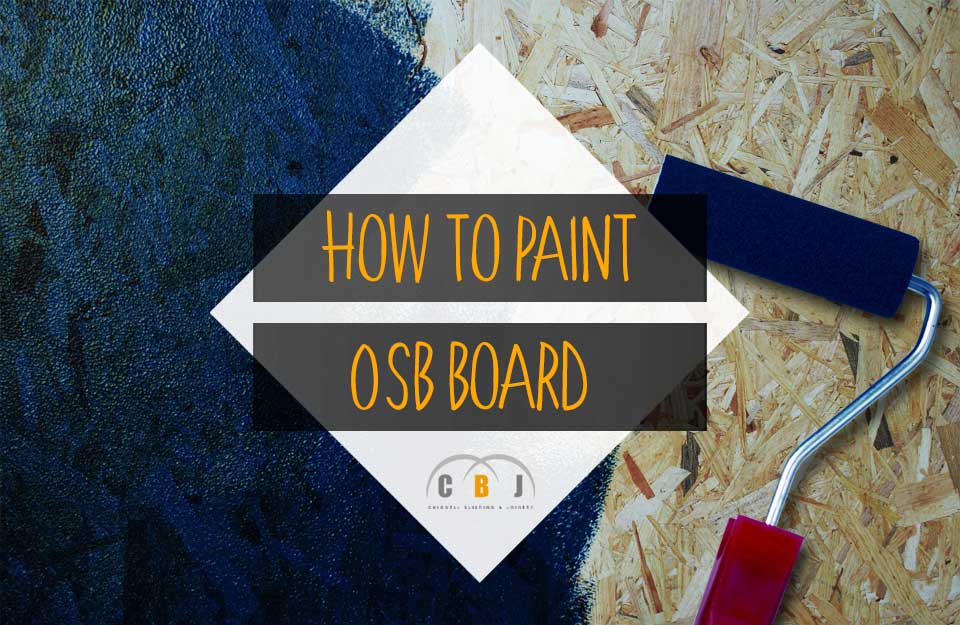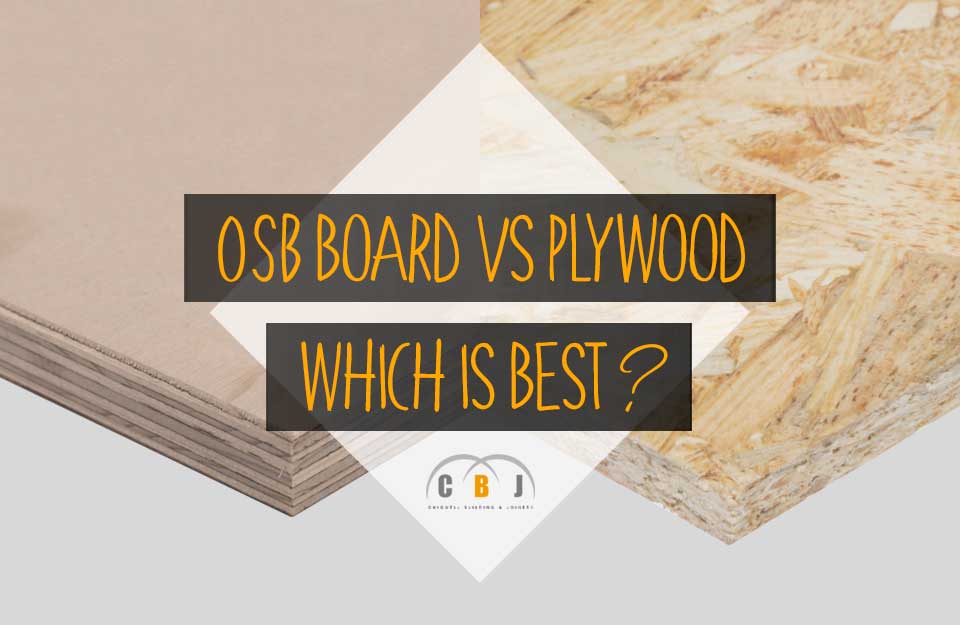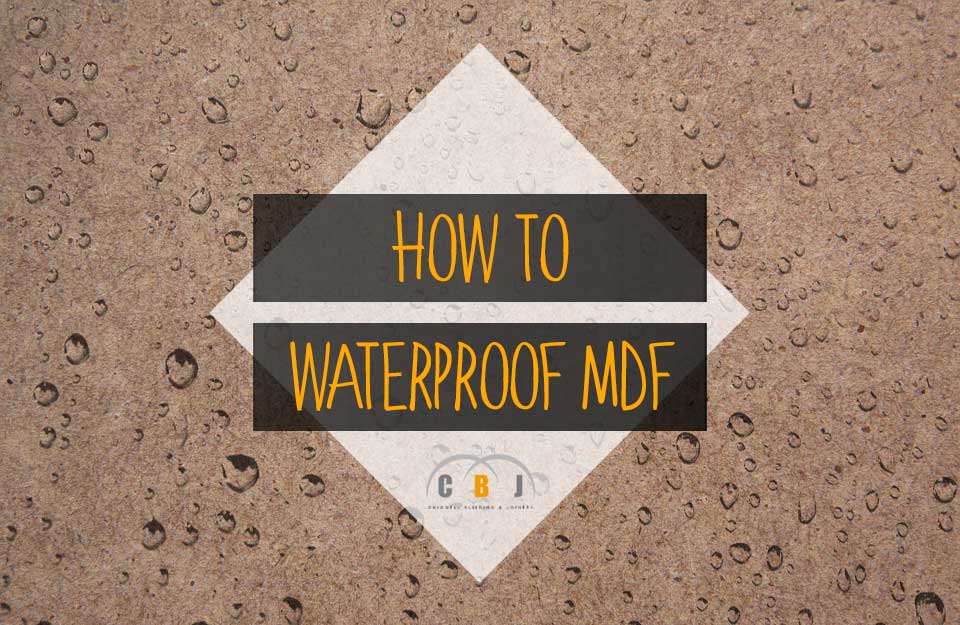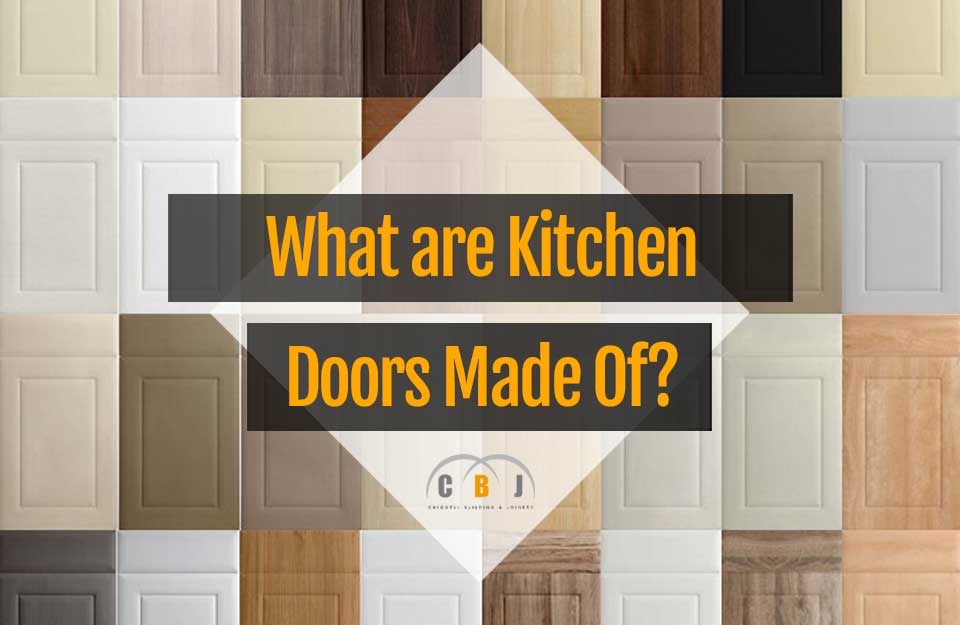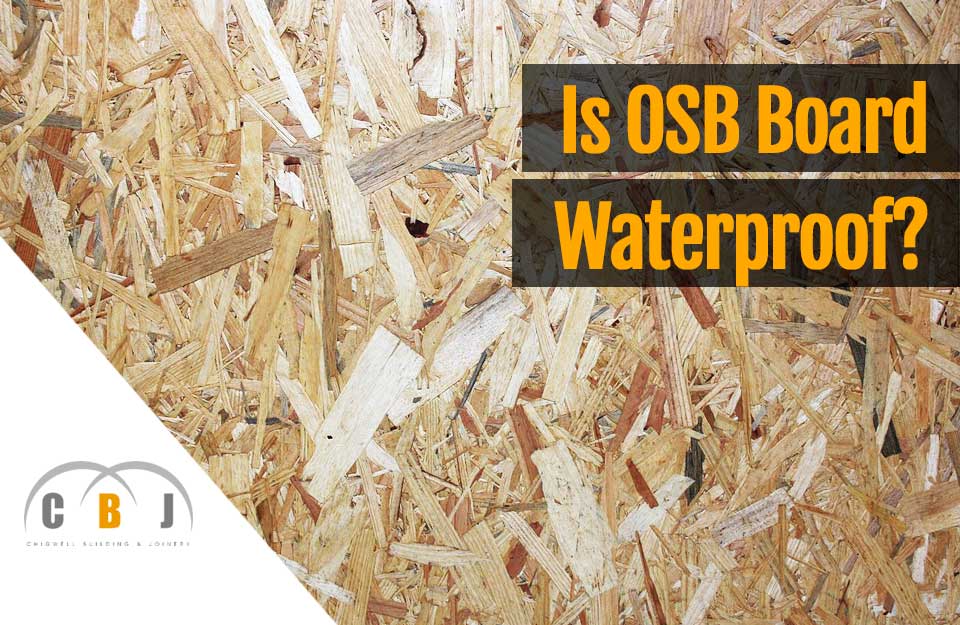News
How to Paint OSB Board
Author Chigwell Building & Joinery
Date 01/12/2022
OSB, or Oriented Strand Board is a popular material used in hardwood flooring, underlayment, wall sheathing, sheds, and roofs.
It is an engineered wood product, which is generally more affordable than plywood, and it has no internal gaps.
Indeed, OSB is considered as a functional option for many building and remodelling projects as it is low cost, and yet considerably strong.
Table of Contents
- What is OSB Board?
- Tools You’ll Need
- Surface Preparation
- Fill Gaps
- Seal Edges
- Priming the Surface
- Using the Right Paint
- Paint Roller vs Spray Painting
- Conclusion
What is OSB Board?
Image credit: Wickes
OSB board is composed of several layers of chipped wood.
These are referred to as strands.
Once they are arranged to be flat and oriented in a perpendicular form to each other, cross-hatched strands with resins are added to create a more stable and solid board.
Many prefer OSB to plywood and other types of wood because it is environmentally friendly, affordable and easy to purchase.
It is also easier to screw into.
While OSB board is mainly used for its functionality, in some cases it is also used as a finished surface.
As a result in such cases, one may wish to paint it to make it look more attractive.
Having said that, there are some things to bear in mind when painting OSB board.
We shall discuss these factors as well as the best way to go about painting such boards in more detail hereunder.
Tools You’ll Need
Image credit: DIY.com
You will need the following tools and materials to paint OSB:
- Paint
- Primer
- Polyester resin filler (optional)
- Wood floor wax stripper (optional)
- 80 grit sandpaper
- Roller tray and thick nap roller cover (19 inch)
- Bucket and screen or a paint tray
- Electric sander
- Dust mask
- Gloves
- Vacuum cleaner
Surface Preparation
Start off by lightly sanding the surface of the OSB using an 80 grit sandpaper on an electric sander.
Make sure not to sand the edges.
Once ready, clean the surface thoroughly.
To do this well, it’s best to use a vacuum cleaner with a brush attachment, since cotton rags or tack cloths will not do the job well enough due to the rough texture of OSB.
Proper surface preparation is of utmost importance.
This is especially due to the fact that OSB board has a thin layer of wax.
This coating is intended to protect it against moisture, but it also inhibits painting.
As a result, it’s best to remove this coating by applying a wood floor wax stripper, prior to painting the OSB.
The board’s texture can also be smoothed out somewhat if you add a polyester resin filler.
Alternate the filler coats with some sanding to smooth out the texture of the cross hatched wood chips of the board.
Fill Gaps
Any gaps in the OSB should be filled up by using a block-filler primer.
This will fill up the gaps in between the wood strands well.
It is also important to fill gaps in OSB as a smoother look can be achieved, and this will help in getting a better paint job.
Seal Edges
Image credit: Amazon
You should try to preserve the factory edges as much as possible.
These will be smoother than those which you need to cut.
And since OSB’s cut edges are prone to water penetration, it’s crucial to seal them.
While factory edges will have already been treated with a sealant, this is not intended to last for a long period of time.
So the edges should be sealed well.
To do this, first apply a resin filler, and then sand.
As a result, the edges will be far more moisture resistant.
Another noteworthy consideration is it’s crucial to avoid exposing the edges of OSB board to water or moisture as swelling and/or cracking could occur.
Despite the fact that OSB is manufactured to withstand moisture exposure to a certain extent, such as occasional rain, it’s highly recommended to avoid permanent exposure of such boards from the elements.
This is because if water is allowed to penetrate the material, swelling and disintegration will result.
Priming the Surface
Primer is crucial to eliminate the possibility of the OSB’s wood fibres to lift and separate due to moisture exposure.
It’s best to use an acrylic latex stain-blocking primer, as this will offer a good coverage and protection, as well as hide any stains on the OSB.
Priming also serves to seal the paint and reduces the possibility of any bleed-through.
Pour primer in a tray, dab the roller in it, and prime the boards making w-shaped sweeps.
After around two hours, apply a second coating of primer.
This process should be repeated until you can see that the OSB’s flaky patterns have been hidden.
Make sure to allow it to dry well before moving on to painting.
Using the Right Paint
It’s very important to use the right paint for OSB.
Ideally, avoid water-based paints since as mentioned earlier, OSB can swell.
Thus, an oil-based primer is recommended.
If you were to paint OSB as if it were plywood or a similar material, the painted surface will end up peeling after a period of time.
It will also look unattractive and regular maintenance will definitely be a must.
Thus it’s essential to opt for oil-based paint.
First, apply a top coat of the paint and allow it to dry well.
Then, repeat the process as it’s always best to apply two coats.
Paint Roller vs Spray Painting
Image credit: Pexels
You might be tempted to spray paint OSB instead of using a paint roller.
However this is not ideal.
Rolling paint will take longer than spraying, but you will achieve much better coverage.
Moreover, you should be aware that if certain paints are used, the OSB’s strands will still remain visible if merely one coat of paint is applied.
Besides, the open strands will absorb paint readily, and hence several coats would be necessary.
As a result, it’s recommended that a filler and heavy primer are applied in order to remove some of the wood’s texture from the board, prior to painting.
Conclusion
OSB is a great alternative to plywood and other materials.
Besides being affordable and environmentally friendly, it’s also readily available at most DIY stores and timber merchants.
However, if you’re going to paint it, it’s important to follow this guide to achieve good results.
OSB can be painted, but this needs to be done properly and carefully, so that in the end you can have a nicely painted OSB project that can last a long time.
OSB Board vs Plywood - Which is Best?
Author Chigwell Building & Joinery
Date 04/10/2022
OSB and plywood are engineered woods that can be used alternatively in building construction.
Both products are made from wood, glues and resin, sharing other similarities.
However, this does not mean they are the same nor that they will perform the same in similar applications.
Builders and homeowners should know the difference between these products and their suitable uses.
In this article, we take an in-depth look at OSB and plywood, identifying its differences and helping readers make well-informed decisions.
Table of Contents
- What is OSB (Oriented Strand Board)?
- How Is OSB Made?
- OSB Durability
- OSB Water Resistance
- Pros of OSB
- Cons of OSB
- What is Plywood?
- How is Plywood Made?
- Plywood Durability
- Plywood Water Resistance
- Pros of Plywood
- Cons of Plywood
- Conclusion
What is OSB (Oriented Strand Board)?
Image credit: Wikipedia
Oriented strand board (OSB) is an engineered wood formed from layers of compressed wood strands adhering to a specific orientation.
The individual wood strands are about 2.5 cm x 15 cm and are laid uneven across each other.
It is a popular choice for sheathing, roof decking and flooring, and it is also great for furniture making.
OSB's combination of wood, wax and adhesive makes it durable for structural building work.
It is resistant to warping, delamination and raking.
How Is OSB Made?
Oriented strand board is made of wood that is shredded into strands.
OSB uses trees such as pines, aspen poplar, and other mixed hardwoods.
The process of manufacturing OSB is divided into 5 steps. These are:
- Picking and debarking
- Stranding and drying
- Blending and forming
- Pressing
- Quality control
Picking and Debarking
Oriented strand boards are made from carefully selected trees like pines, aspen poplar, and other hardwoods.
These trees come from a sustainably managed forest.
They are grown and harvested every 10-15 years, making sourcing very sustainable.
After harvesting these trees, they are sent to the manufacturer for debarking.
Debarking means simply removing the bark from the trees.
The removed bark is used as a source of fuel for the drying process.
It is a great eco-friendly process.
Stranding and Drying
Next, the debarked trees are sent to the strander machine.
The strander machine is composed of precision blades moving at 2500 pm.
They are programmed to cut the trees into strands in predetermined dimensions, thicknesses, widths, and lengths.
Once the stranding process is completed, the strands are moved to a dryer.
The dryer is powered by fuel from the debarks of trees.
They are programmed at a certain temperature and help reduce the moisture in the strands.
Note that the dryer does not eliminate the moisture in the strands.
Blending and Forming
Wood strands are moved in for blending and forming.
It involves mixing the strands with adhesive resins (such as urea-formaldehyde; phenol formaldehyde resin on its surface; and poly-methylene diphenyl diisocyanate in the inner region).
Then the wood is bonded together and cut into rectangular mat sizes.
Pressing
Next, the mats are moved onto a presser that could weigh up to two million pounds.
The presser compresses the strands into a single board using up to 7500 psi and over 400 degrees Fahrenheit.
The finished product from here is recognisable as OSB, but the process doesn't end here.
Quality Control
All these processes are carried out in a highly controlled environment.
They ensure that the boards are of similar quality, and they reduce the number of defects.
Computerised processes are employed to reduce human errors.
In the United Kingdom, OSB manufacturing and use are governed by EU standards until January 2023.
OSB must comply with designated EU or UK standards for wood panels, including the (BS)En 13986: 20004+A12015.
OSB Durability
OSB and plywood are durable materials.
The level of durability will vary amongst them.
Regarding how they perform in a moist environment, OSB is slower in absorbing water.
Its resistance to moisture makes it a desirable choice in damp areas.
However, it has been known to swell, especially on the edges and it does not return to its original shape, even after drying.
In terms of strength, OSB is similar to plywood.
It can lift the same weight as plywood.
OSB is heavier than plywood and more consistent.
In summary, OSB is great for home construction and can last a long time if maintained well.
OSB Water Resistance
Quality OSB can resist water damage.
The strands that make up the board are coated with adhesive resin and wax.
These substances give strength, durability, and waterproofing to the OSB.
The OSB grade 1 will resist damage from rain during harsh weather.
But excessive exposure to rain over a long period of time will damage the board.
Signs of damage to the board can be noticed at the edge of the OSB.
As it absorbs water, the edges begin to swell and expand.
Soon the edges begin to delaminate and break.
The board is excellent as a waterproofing system and is used for walls, subfloors, and roofing.
In addition, there are different grades of OSB.
Some are designed to provide more resistance to water and moisture exposure than others.
The grade of OSB should always be factored in.
Overall, do not expose OSB to excessive moisture.
Pros of OSB
- OSB is built to be consistent from one side to another.
- OSB does not have the knots, holes, and defects that are common with plywood.
- Its consistency allows for easy use and structural integrity.
- OSB is sourced from an eco-friendly and sustainable process. The trees are planted and harvested every 15 years. And every aspect of the tree, including the bark, is used during manufacturing.
- OSB is denser and stronger than plywood. This is one major reason for its growing popularity amongst builders, especially when it is used in flooring.
Cons of OSB
- Although OSB is stronger than plywood, there is a concern that it is too flexible, especially when used for flooring. The flexibility may cause the floor to be squeaky.
- There is a false perception that OSB is of low value for money. On the contrary, OSB is one of the best-engineered woods available for construction.
- Some users of OSB have criticised the board for looking unfinished. However, there are several creative ways to design OSB board for it to look very appealing to the eye.
What is Plywood?
Image credit: Wikipedia
Plywood is a type of engineered wood manufactured from wood veneers (thin slices of wood).
It is glued to resin, with each adjacent layer of wood having its grain rotated 900.
The process of rotating the wood grain is referred to as cross-training.
Cross-training helps to reduce wood splits during nailing.
It also reduces the effect of expansion and contraction.
The grains are arranged oddly so that the board is balanced.
This odd arrangement helps to reduce warping.
How is Plywood Made?
Plywood is made using different procedures depending on the intended use.
For instance, plywood used in construction is cut into flat boards, while plywood for furniture or aircraft use is cut into curves.
Picking and Debarking
Plywood is made from woods like oak, poplar, Monterey pine, Okoume and many others.
The trees are cut into logs and prepared for debarking.
Next, carefully selected trees are sent in for debarking. It means removing the bark from the logs.
Debarking is done mechanically with a machine with teeth blades on its end.
Slashing and Clipping
The logs are moved on to the slashing process.
Each piece of wood is slashed into 8-foot logs and measured for quality control.
Next, they are moved onto a roller cutter and cut into long ribbons.
The ribbons are usually 1/8th of an inch thick.
The ribbon is moved onto the clipping table; clipped into 4 x 8 sheets and stacked together for drying.
The veneers are then thoroughly dried until moisture is removed.
The dryer is about 4000f so that it can work to specification.
Coating and Pressing
The veneer is placed in a feeder and is made to run through a glue curtain that coats the sheets.
The wood grain is layered up oddly, and the wood is 15 layers thick before reaching the pressing stage.
Then the pressing stage compresses the layers with weight and heat.
The glue is heated to bind the sheets together firmly.
The boards are then finally coated and cut.
Plywood Durability
Plywood is very durable and is manufactured to be of high impact resistance.
Different grades of plywood have various levels of durability and levels of resistance to high impact.
So, consider the level of impact the plywood will come under when considering the grade of plywood that will be purchased.
Plywood should not be exposed to excessive humidity – this is damaging to the board and affects its durability.
Exposure to adverse conditions will affect the service life of the wood.
Plywood Water Resistance
Plywood comes in different grades, and performance in wet conditions will vary.
The truth is that wood products do not mix well with water exposure.
Plywood is treated with resins which may slow water damage to the plywood.
A small amount of water exposure or moisture will not damage the plywood.
Excessive exposure to water will cause the wood to absorb the water and expand, causing the wood to split.
In summary, avoid exposing the plywood to excessive water.
Pros of Plywood
- Plywood is strong and it can occasionally carry heavy loads and come under strain. This makes it very suitable for flooring or formwork.
- Plywood cross-graining helps to distribute the impact on the graining.
- Plywood’s laminated structure provides stability in construction work.
- Plywood is lightweight compared to OSB and is easy to work with. Its light weight makes it suitable for furniture making. Lightweight plywood does not have reduced strength.
Cons of Plywood
- Plywood costs more to get a certain size of plywood compared to OSB of the same size. Although, there are high-grade types of OSB that may cost as much as plywood.
- Another drawback is that plywood can be difficult to saw through. The wood tends to splinter, creating rough and uneven edges. Sawing plywood requires expertise.
- There’s a concern that plywood releases volatile organic compounds into the air. VOC is an unsafe compound that can be poisonous to humans. This process of the release of VOC is common during construction and handling.
Conclusion
OSB and plywood are great for construction work.
OSB is cheaper than plywood but that does not mean it is inferior in quality.
Plywood may be more suitable for flooring than OSB.
Make sure to consider such pros and cons before purchasing any timber building product.
How to Waterproof MDF
Author Chigwell Building & Joinery
Date 30/08/2022
MDF is a popular alternative to natural wood utilised in various settings.
MDF is denser than plywood, another synthetic wood, and a relatively cheaper option.
One major problem with MDF is its low tolerance to humid and moist conditions. It tends to absorb water which destroys the material.
In this article, we’ll take an in-depth look at MDF and outline steps to waterproof it effectively.
Table of Contents
- What is MDF?
- Is Standard MDF Waterproof?
- Benefits of Using MDF
- Making MDF Waterproof
- Tools Required
- Conclusion
What is MDF?
Medium-density fibreboard (MDF) is a type of engineered wood.
It consists of wood by-products, shavings, sawdust, and other residual fibres.
The wood by-products are dried and grounded into powder.
It is then mixed with wax and resin and subjected to a high-pressure press into flat panels by mechanical means.
There are various types of MDF, including:
- Standard MDF
- Ultralight MDF
- Moisture Resistant MDF
- Fire Retardant MDF
- Exterior Grade MDF
- Valchromat MDF
- Melamine Faced MDF
Is Standard MDF Waterproof?
Standard MDF is not waterproof, and only short term exposure to water will damage it because it will typically be absorbed.
This exposure will cause the MDF to swell, rendering it useless.
MDF is made of wood fibre bound together by resin adhesive, making it moisture resistant.
But it is not waterproof, and little cuts or prolonged exposure to water will damage it.
For this reason, standard MDF is suited for indoor use, such as for cabinets, shelves, and other objects in places with low moisture or humidity.
Remember that waterproofing your MDF does not offer protection from prolonged exposure to water however.
Benefits of Using MDF
Besides the fact that MDF is less expensive than plywood, there are other benefits to using MDF in your home.
They include:
- MDF's density and shape make it solid and less likely to warp out of shape.
- MDF is easy to drill and cut without damaging the surface. Its durability is due to its composition.
- It works well with carpentry adhesives and polyurethane glues. In addition, MDF glues easily to most materials.
- MDF can easily be fastened together with screws and nails without damaging the surface.
- It is easy to paint.
- MDF can easily be cut and designed to create decorative door panels and other features around the home.
- MDF is a perfect substitute for plastic laminate and veneer as it has the appearance of real wood without the cost.
- MDF is resistant to termites due to the chemicals treatments (such Boric acid, Borax, and urea-formaldehyde) used when manufacturing it.
- MDF is eco-friendly and can be recycled.
Making MDF Waterproof
There are two methods to waterproof MDF.
You can opt for using manufactured Moisture Resistant MDF, which is a little more expensive than standard MDF.
Or you can paint your MDF with moisture-resistant wood sealant or varnish.
Painting your MDF will require you to apply several coats of wood sealant and waterproof paint to its surface.
Either option provides the MDF with protection against moisture.
However, prolonged exposure to water will damage the MDF regardless of the protection provided.
Tools Required
- A quality wood sealant or varnish
- Paintbrush
- Sandpaper
- Roller tray liner
- Roller tray
- ⅜ inch Roller cover
Step One: Prepare Tools
Fix your ⅜-inch roller cover into its roller.
A ⅜-inch roller is recommended to maximise the spread of the paint on the MDF board.
Place a roller tray liner inside the roller tray.
Step Two: Apply Sealer
Apply the sealer to the edges using the paintbrush.
Ensure that all edges are properly covered, and that there’s no drips.
Proceed to apply the sealant to the surface.
We recommend applying at least two coats to the MDF surface.
Let it dry for at least 5 hours.
Clean the surface of the MDF and prepare tools for painting.
There are different sealants for waterproofing.
The most popular method, and the one recommended is primer sealant.
Other methods of sealant include:
Bondo technique
This method involves applying the Bondo filler across the edges and surface of the MDF.
This provides an adequate seal.
The only drawback is Bondo dries easily, and may not be suitable for larger jobs.
Water & glue technique
The technique is cheap and very effective.
It involves mixing water and glue in a container before applying it to the MDF as a sealer.
The only setback of this method is that you may need to add another coat after it has dried, as it’s not always visible during application.
Glazing putty technique
Glazing putty is a great sealer and easy to sand after painting.
It’s not as hard as the Bondo substance however.
Primer technique
Primers are the recommended sealer as they help bond the waterproof coat to the MDF.
Step Three: Apply Moisture-Resistant Paint
The next step is applying the first moisture-resistant paint coat on both sides.
You can sandpaper the edges to ensure a smooth feel.
Once the coat is dried, it is recommended to apply a second coat to ensure the MDF is properly covered.
Paint the edges of the MDF boards too.
Leave the paint to dry for at least two days.
Conclusion
As mentioned above, MDF is a solid alternative to natural wood.
It is also your best bet if you want something aesthetically pleasing, yet more economical than plywood.
Remember, you don't want to expose MDF to humid or moist conditions, so you should be mindful of where you’re going to use it.
There are types of MDF that can work in harsh or wet weather conditions, so you should always do your research before using this highly versatile building material.
What Are Kitchen Doors Made Of?
Author Chigwell Building & Joinery
Date 01/08/2022
As soon as you walk into a kitchen, the first thing you notice is the kitchen cabinet doors.
The style, the material and colour are all important aspects, and this inevitably makes it even more important to choose carefully and wisely.
It's also critical to take into account the various pros and cons that different materials offer.
This will help you strike the right balance between style and quality.
Table of Contents
- Solid Wood
- Melamine Faced Chipboard (MFC)
- Veneered Chipboard
- Veneered MDF
- Foil Wrapped MDF
- Painted MDF
- Vinyl Wrapped MDF
- Acrylic Faced MDF
- Toughened Safety Glass
- Conclusion
Solid Wood
Image credit: Pixabay
Solid hardwood is one of the most expensive options.
But there's no denying that you'll be investing in durable and high quality kitchen cabinet doors.
Solid wood is able to put up with the daily wear and tear that kitchen doors are subjected to.
This includes the numerous bumps and knocks that are even more common if you have children or pets.
Another key advantage of solid wood doors is they always stay in style as they have a timeless beauty.
Moreover, there are countless colours to choose from.
For many people, nothing beats that natural look that can be offered by the various types of solid wood options.
These include cherry, oak, pine, hickory, birch and walnut.
Solid wood doors are also customisable according to one's preferences.
Despite the numerous advantages of solid doors, one will need to bear in mind that besides being expensive, they also require considerable maintenance.
A waterproof finish should be given to such cabinets, and it's crucial to clean them with specialised non-abrasive products.
Such solid wood doors also have the drawback of being reactive to humidity, so they can warp and crack.
Melamine Faced Chipboard (MFC)
Image credit: CBJ Ltd
MFC kitchen doors are another popular option as they are affordable, yet very stylish.
If you cannot afford hardwood doors, melamine face chipboard is a great alternative as they're far more budget-friendly.
They're also available in a wide variety of colours, from a natural finish to a more contemporary look.
MFC is made from resin coated particles of softwood.
Such particles are evenly spread out over a flat plate.
Then, they are bonded together by applying extreme high pressure.
Subsequently, the melamine face is laminated on top as a decorative finish.
During this manufacturing process various textures can be applied.
This allows for a variety of finishes that can be achieved, including matt, gloss and embossed wood grain effects.
Veneered Chipboard
Image credit: Mebelissimo
Veneered chipboard is a fairly common kitchen door material.
A veneer is a thin layer of timber which is bonded to the chipboard and then sealed with stain and/or lacquer.
Veneered chipboard cabinet doors are quite affordable and durable.
Another advantage is they preserve consistency of the grain colour and pattern.
Veneer cabinets can provide both the look as well as the feel of natural wood, and they are easy to maintain.
However, it's important to remember that they should not be subjected to excess moisture.
If this occurs, the veneer can loosen from the substrate, resulting in a bubbled look in certain areas.
Veneered MDF
Image credit: Builder Depot
Similar to veneered chipboard, the main difference is the veneer is bonded to a medium density fibreboard substrate, instead of chipboard.
MDF is considerably durable and yet relatively inexpensive, making it a great option for many.
Veneered MDF doors do not require specialist care as they can be maintained simply by wiping down with a soft, lightly dampened cloth.
It's important to avoid excessive exposure to water as they are vulnerable to moisture penetration.
Any nicks and scratches can be buffed out easily in many cases.
So it's safe to say that such doors are resistant to warping and are reasonably durable.
Foil Wrapped MDF
Image credit: Kitchen Findr
In this case a layer of vinyl or foil is wrapped and bonded onto an MDF substrate.
Foil consists of paper mixed with resin, whereas vinyl is a thin layer of plastic.
Both are commonly used to manufacture kitchen cabinet doors as they offer increased durability coupled up with various stylish options.
This material is very versatile as it can be printed in countless different ways.
From natural wood grains to a simple single colour finish, as well as opting for matt or high gloss depending on one's preferences.
Painted MDF
Image credit: Advanced Timber Finishing
Painted MDF is another option which is fairly common.
Applying several coats of high quality paint or lacquer to the MDF substrate offers a greater choice of colours and styles to suit diverse preferences.
First the doors are primed and cured.
Following such a process the doors are finely sanded, and a top coat is applied.
Subsequently, the doors are returned to the oven for additional curing.
This helps to create a tougher, more durable surface.
Needless to say, the most obvious benefit of such kitchen doors is there's countless colours one can choose from.
Having said that, it is important to be realistic and choose a colour which will have a timeless appeal.
You do not want to end up getting bored of it or find it looks dated in a few years time.
Some colours may go out of fashion, so bear this in mind when choosing.
Painted MDF doors have the advantage of lasting longer and you won't need to worry about peeling.
It's a good idea to store a pot of the colour matched touch up paint however, so in case of any chips or scratches you can repair them easily.
Painted MDF doors may end up being quite expensive if the kitchen is quite large.
So bear in mind that this is definitely not the option which can offer you the best in terms of durability.
Vinyl Wrapped MDF
Vinyl wrapped MDF has become one of the most popular options.
This material is relatively affordable, and yet it can still offer you considerable durability.
Vinyl wrapped doors are either compressed or composite wood doors, onto which a vinyl wrap is laid.
As a result, such doors are highly resistant to moisture and humidity, as well as changes in temperature, making them ideal for a kitchen.
Vinyl wrapped MDF is available in a wide range of colours and patterns, allowing you the possibility of being spoilt for choice.
Acrylic Faced MDF
Image credit: MIH Building Material
Acrylic faced MDF cabinet doors are a relatively cost effective option.
Such doors are made by applying a thin layer of high gloss acrylic to the MDF.
This is bonded to the substrate, offering a stylish and more durable finish to the doors.
Acrylic is a non-toxic material which is ideal to give a high gloss finish to kitchen doors.
It is particularly popular for those who have a rather small kitchen, as the high gloss finish will reflect light, making the kitchen look more spacious.
Cleaning and maintaining such cabinet doors is also simple.
One will not have to worry about cracking or chipping as this is highly unlikely with such a material.
Moreover, the vast range of colours that one can choose from is a great advantage.
The main drawbacks of acrylic faced MDF cabinet doors is that regular cleaning is often necessary.
Fingerprints, dirt and stains can be a common problem, and are easily visible on the glossy surface.
Toughened Safety Glass
Image credit: Pexels
Glass doors used to be very popular back in the day.
Over the years other materials started to be favoured, but lately glass doors are making a comeback.
Glass doors are made from toughened safety glass and can be quite costly, especially if you have a large kitchen.
Many people favour these doors because they allow you to see what's stored inside the cupboard without having to open them to find for what you need.
On the other hand, it's important to ensure you have a well-organised and tidy setup within the cupboards as everything will be in plain sight.
Such doors are relatively easy to clean and are scratch-resistant.
Moreover, they are not affected by heat or humidity.
Conclusion
Since there are so many different kitchen door material options available, it's a good idea to meet up with a kitchen cabinet specialist to discuss your needs.
They can help to find the right style option which will align with your particular preferences and budget.
Finding a material that's cost effective and able to fit into your home and lifestyle is important.
The kitchen is the hub of the home, so you want to get this important decision right the first time!
Is OSB Board Waterproof?
Author Chigwell Building & Joinery
Date 01/07/2022
OSB or Oriented Strand Board, has become a popular alternative to traditional plywood.
While it offers a number of benefits, many are still concerned whether it’s robust enough if exposed to water or high levels of moisture.
Table of Contents
- What is OSB Board?
- Is OSB Board Waterproof?
- Should I Waterproof Seal OSB Board?
- Can OSB Board Get Wet?
- Can I Use OSB Board Outside?
- How to Protect OSB Board from Rain
- How to Make OSB Board Waterproof
- Conclusion
What is OSB Board?
Image credit: Wikipedia
OSB was invented back in 1963 by Armin Elmendorf.
This wood sheeting is made from 95% wood chips and 5% adhesive.
Indeed, OSB is made by mixing resin with strands of young wood to achieve a hard board.
This is then waterproofed to increase its durability.
This is very important especially if the OSB boards will be used in outdoor applications.
OSB boards are becoming quite popular as they are considerably thicker than plywood boards, and thus stronger than its counterpart as well.
OSB boards are used in various applications, including flooring, roof decks and even to make furniture.
Is OSB Board Waterproof?
OSB is made using waterproof resin adhesives.
The process that such boards undergo to be manufactured makes them highly water resistant.
This is due to the fact that the voids between the strands are very small.
Whatever gaps may be present, they will be filled with heat-cured waterproof resin adhesive and wax, in order to bond the wood chipping to each other.
As a result, all the wood strands in the board are coated, making the board water-resistant.
The edges are also treated with a sealer.
This gives the board additional moisture protection.
Even though OSB boards undergo such a process during manufacturing, it’s still best to fortify them with additional moisture protection before using them in an actual application.
This is because OSB boards are not exactly 100% waterproof, but are more accurately considered reasonably water-resistant.
It’s impossible to prevent water absorption completely as at the end of the day, this is a wood-based product.
However when compared with other types of materials, such as MDF boards for example, OSB is considerably better when it comes to moisture resistance.
Should I Waterproof Seal OSB Board?
Yes, it is a good idea to waterproof seal OSB boards.
When buying OSB boards, make sure that they have the ‘waterproof’ mark applied.
This is found on the back of the boards.
Despite this, it is still recommended to waterproof OSB boards, especially if they are going to be in an outdoor setting.
Can OSB Board Get Wet?
Image credit: Wikipedia
Generally speaking OSB boards are able to withstand 4 weeks of continuous moisture exposure.
There are even some which are rated to withstand up to 200 days of exposure without sustaining any damage.
However, if untreated cut boards are exposed to rain or standing water, the moisture absorption will be too excessive, so there’s a chance that swelling could occur.
If water exposure is prolonged, delamination is highly likely to result.
Therefore, OSB boards should not be left to get wet unnecessarily.
Painting or staining, and undergoing a waterproofing treatment is highly recommended, especially if the boards will be in an exterior setting.
Long term moisture exposure should be avoided, and if possible the boards should be covered or protected.
Can I Use OSB Board Outside?
OSB board can withstand exposure in an outdoor setting quite well.
It is important that if it’s going to be left outdoors, you choose OSB boards that are highly moisture resistant.
Hence, the boards should be packed with more strands, resin and wax to have superior moisture resistance level.
Such boards are classified as class 3 and they are the best type for humid conditions.
Such boards should also be given an additional layer of waterproofing as described above.
This offers them more resistance against moisture and water, which will inevitably be more present in an outdoor setting.
How to Protect OSB Board from Rain
If OSB boards are going to be left outdoors, ideally they should be covered to protect them from rain and moisture.
An odd rain shower should not cause much damage.
But if they’re exposed to several hours of rain, then they could end up swelling.
Covering with tarpaulin is also a good option to protect OSB boards from rain.
Another option is to spray them with exterior grade paint or a water sealer.
This is especially important for any cut edges on the boards.
If the boards have been used on roofs, they could be covered with roofing paper.
If they are used on walls they could be covered with a weather resistant barrier before siding.
Priming, painting or staining after construction has been completed is important.
How to Make OSB Board Waterproof
Image credit: Amazon
Make sure that you plan carefully before cutting the boards.
This is because whenever you cut, the sealer that was at the edges will be removed, and as a result moisture can be absorbed more easily into that area.
So waterproofing will need to be done after you’ve made the required cutting.
To make OSB boards more water resistant you can paint them.
If you are going to do this, it is best to paint them prior to carrying out the waterproofing process.
This will enable the paint layer to also be protected from water and moisture.
You may choose either latex-based or oil-based paint.
To waterproof OSB boards, choose a good quality waterproofing solution from any local hardware store.
Check that it can be applied to wood.
The solution can be applied by using a paintbrush, while making sure you coat all the board.
It is best to apply a second coating, and allow around 12 hours for the waterproofing to dry sufficiently.
Conclusion
OSB is a timber construction material that’s highly resistant to moisture.
When compared to other types of wood panels, it has a much slower moisture absorption rate.
Additionally, it can be water and weatherproofed for additional resistance, especially if it is going to be used outdoors.
This can be done very easily by using water repellent paints or stains.
